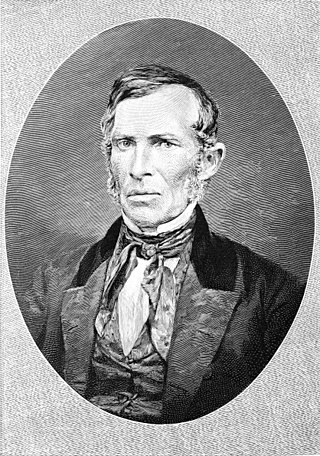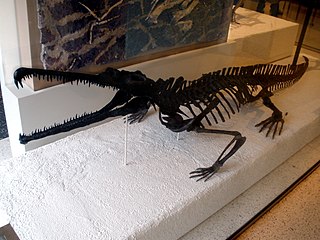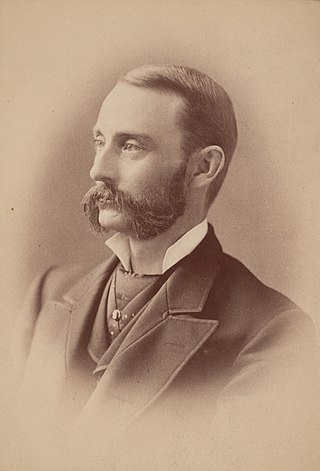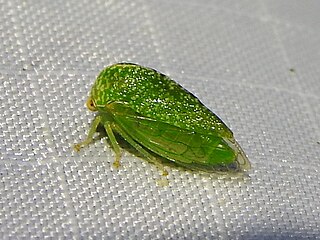
The Aristolochiaceae are a family, the birthwort family, of flowering plants with seven genera and about 400 known species belonging to the order Piperales. The type genus is Aristolochia L.

Arundinaria is a genus of bamboo in the grass family the members of which are referred to generally as cane. Arundinaria is the only bamboo native to North America, with a native range from Maryland south to Florida and west to the southern Ohio Valley and Texas. Within this region Arundinaria canes are found from the Coastal Plain to medium elevations in the Appalachian Mountains.

Ebenezer Emmons, was a pioneering American geologist whose work includes the naming of the Adirondack Mountains in New York as well as a first ascent of Mount Marcy.

The pygmy brocket is a brocket deer species from South America. It is found in southern Brazil, Argentina and Paraguay. It is a small deer with short legs, weighing 15 to 20 kilograms. It is reddish-brown in color.

The Central American agouti is a species of agouti from the family Dasyproctidae. The main portion of its range is from Chiapas and the Yucatan Peninsula, through Central America, to northwestern Ecuador, Colombia and far western Venezuela. A highly disjunct population is found in southeastern Peru, far southwestern Brazil, Bolivia, western Paraguay and far northwestern Argentina. The disjunct population has been treated as a separate species, the brown agouti, but a major review of the geographic variation is necessary. The Central American agouti has also been introduced to Cuba and the Cayman Islands.

The IMOCA, is a 60ft development class monohull sailing yacht governed by the International Monohull Open Class Association (IMOCA). The class pinnacle event are single or two person ocean races, such as the Route du Rhum and the Vendée Globe and this has been intimately linked to design development within the class. The class is recognised by World Sailing.

Rutiodon is an extinct genus of mystriosuchine phytosaurs from the Late Triassic of the eastern United States. The type species of Rutiodon, Rutiodon carolinensis, encompasses a large number of skulls and assorted postcranial fossils discovered in the Cumnock Formation of North Carolina. Fossils referable to the species are also known from Pennsylvania, New Jersey, and Virginia. Rutiodon carolinensis is the most well-described species of phytosaur in eastern North America, though its validity as a natural taxon has been questioned. Some paleontologists also recognize a larger and more robust species, Rutiodon manhattanensis, which is known from teeth and postcranial fossils from New Jersey and Pennsylvania.

George Ferdinand Becker (1847–1919) was an American geologist. His most important work was in connection with the origin and mode of occurrence of ore deposits, especially those of the western United States.

Football was the optional sport at the 1979 edition. Between 1985 and 2019, football was a recognized mandatory sport. The women's football competition began in the 1993 edition as optional event. Due the creation of the FISU University Football World Cup in 2019, the sport will no longer be part of the Summer World University Games program starting at that year. With this change, the number of mandatory sports will be kept at fifteen, since the place will be occupied by badminton which after five editions as an optional sport turned a compulsory sport.

Herpetogramma pertextalis, commonly known as the bold-feathered grass moth, is a species of moth of the family Crambidae. It was first described by Julius Lederer in 1863 and is found in North America.
The 2013–14 figure skating season began on July 1, 2013, and ended on June 30, 2014. During this season, elite skaters competed at the 2014 European Championships, Four Continents Championships, World Junior Championships, and World Championships, as well as the 2014 Winter Olympics. They also competed at elite events such as the Grand Prix series and Junior Grand Prix series, culminating at the Grand Prix Final.
Louise H. Emmons is an American zoologist who studies tropical rainforest mammals, especially rodents. She has conducted fieldwork in Gabon, Sabah (Borneo), Peru, and Bolivia. Her best known work is the field guide, Neotropical Rainforest Mammals: A Field Guide, first published in 1990, with a second edition in 1997.
Glossonotus is a genus of treehopper belonging to the family Membracidae. There are five described species in Glossonotus.

Cyrtolobus is a genus of treehoppers in the family Membracidae. There are more than 50 described species in Cyrtolobus, found in North and Central America.

Cyrtolobus vau is a species of treehopper belonging to the genus Cyrtolobus. It was first described by Thomas Say in 1830.

Cyrtolobus tuberosus is a species of treehopper belonging to the genus Cyrtolobus. It was first described by Léon Fairmaire in 1846 as Thelia tuberosa.

Cyrtolobus togatus is a species of treehopper first described by L. B. Woodruff in 1924.
Cyrtolobus acuminatus is a species of treehopper belonging to the genus Cyrtolobus and was first described by L. B. Woodruff. It is found in midwestern United States.

Cyrtolobus dixianus is a species of treehopper belonging to the genus Cyrtolobus. It was first described by L. B. Woodruff in 1924.
Cyrtolobus clarus is a species of treehopper belonging to the genus Cyrtolobus and the family Membracidae.















